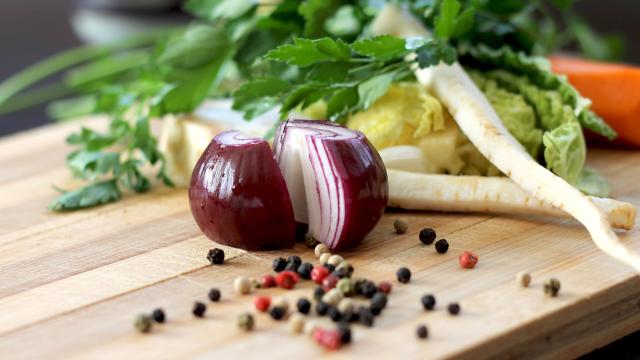Stock is the backbone of so many recipes. Whether it’s used as a cooking liquid for rice or beans, or as the base of a soup or gravy, the quality of your stock influences the quality of your final dish. Though it isn’t hard to make, there are a few tweaks you can make to ensure yours is a rich and tasty stock that’s anything but watery.
[referenced url=”https://www.lifehacker.com.au/2017/11/how-to-roast-a-whole-head-of-garlic/” thumb=”https://i.kinja-img.com/gawker-media/image/upload/t_ku-large/ghdn5gyp8pa8vnfdpzfa.jpg” title=”How To Roast A Whole Head Of Garlic” excerpt=”Garlic is great in all of its many forms but, like most plant parts, it is at its absolute best when roasted. Roasting garlic mellows its pungency and tempers its aggressive bite, but it also intensifies its sweetness and creates new, deeper flavours through that lovely little Maillard reaction. It’s also a freaking cinch to make.”]
I have never in my life used a recipe to make stock, mainly because I just make it out of whatever veggie scraps and bones I’ve squirrelled away. For me, it’s simply a matter of tossing a 4L freezer bag worth of scraps – both animal and vegetable – in a big pot, adding enough water to cover everything, and letting it all simmer away for at least five hours, skimming “scum” off the top and adding more water as needed. Alternatively, you can chuck it all in a pressure cooker and cook it on “high” for 60 minutes. Both routes will give you a wonderfully flavorful stock perfect for soups, stews and gravies.
- Wing it: Besides homemade Buffalo wings, the highest calling for a poultry wing is stock. Though wings may be lacking in meat, they more than make up for it in fat and collagen, which is what you need to make an extra rich stock. Chicken feet also excel here.
- Get scrappy: Keep two 4L freezer bags in your freezer – one for veggie ends, skins and peels (especially garlic skins), and one for animal bones. Once you have enough to fill a pot, you’re ready to re-stock your stock.
- Roasting adds flavour: Roasting your vegetable bits – whether scraps or whole pieces – in the oven before adding them to your stock pot will add a depth of flavour you won’t get from raw, and give your stock a darker colour. Roasted bones taste better too, so save that rotisserie chicken carcass.
- Cheese rinds are your friend: Never, ever toss a Parmesan rind. Those things impart salty umami like whoa, and should be simmered along with the rest of your scrappy friends.
- Dried mushrooms add depth: Though there is nothing wrong with the fresher fungi, dried mushrooms have a deeper, more concentrated flavour.
- Add acid: A bit of vinegar can help break down the collagen in your bone of choice resulting in a richer, more-gelatin-packed liquid with a rounder mouthfeel.
- Aromatics are important: Leafy herbs and other plant parts add freshness and flavour, and keep your stock from being one-note. A couple of sprigs of thyme, a bay leaf, and whole peppercorns always help, but don’t shy away from lemongrass, ginger root or dried chillies.
Once your stock is done simmering – give it a taste to make sure it’s to your liking – drain it, chill it, and get it in the fridge. Remove the solidified fat off the top, transfer to a container with a lid, and store in the fridge for a couple of days (or in the freezer).
This is part of The Grown-Up Kitchen, Skillet’s series designed to answer your most basic culinary questions and fill in any gaps that may be missing in your home chef education.
This article has been updated since its original publication.

Comments